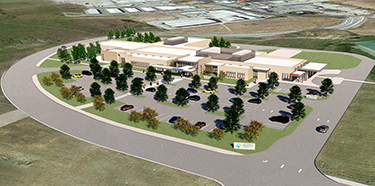|
Subscribe / Renew |
|
|
Contact Us |
|
| ► Subscribe to our Free Weekly Newsletter | |
| home | Welcome, sign in or click here to subscribe. | login |
Construction
| |
 |
February 27, 2020
Hospital projects in rural areas face extra obstacles
CollinsWoerman

Barlet
|
Critical access hospitals are vital to rural America.
They provide much-needed health care services to remote communities that would otherwise be underserved. Nevertheless, in the current health care climate many critical access hospitals are closing as they struggle to find the right combination of sustainable services, staff and facilities.
In addition to these tangible factors, money is an influential component of the success or underperformance of critical access hospitals. Unfortunately, capital is often scarce in many of these rural communities.
CollinsWoerman has spent over a decade working with a small hospital within Chelan County facing similar hurdles, exploring various options and solutions with the community. As the project gets closer to the design finish line, the facility CollinsWoerman is designing bears little resemblance to the one drawn many years before as a result of ever-evolving project and community components.
More than 10 years ago, CollinsWoerman began meeting with the Chelan Public Hospital District to discuss a replacement for the aging Lake Chelan Community Hospital (LCCH). The hospital served a large though sparsely populated area in north Chelan County. The next-closest facility was in Wenatchee, a minimum 45-minute drive for many Chelan residents.
The number of year-round Chelan residents was subnormal, perhaps 7,000 or so, with permanent resident growth projections for the city of Chelan and surrounding area being very little. However, a key driver for the facility was the vacation and recreational community, with the resident count growing to over 30,000 from Memorial Day to Labor Day.
The seasonal census for the recreational community demanded an upgrade to the current facilities, which had been built in the early 1960s.
As one might imagine, the seasonal community had specific needs, including easy accessibility to emergency and urgent care services, while the permanent residents may require services associated with chronic care and disease management. The different health care needs for each population had to be taken into consideration when best approaching critical access hospital design for this diverse-needs community.
Stops and starts
Prior to CollinsWoerman being asked to assist the community in this project, the organization already had plans to expand their aging facilities. The design was put to the test by a community bond vote, but failed by less than 100 ballots.
CollinsWoerman was selected to move forward with new leadership to develop a new design. The firm brought ample experience in the design of rural critical access hospitals and quickly sized up the issues of the existing site and potential expansion.
CollinsWoerman recommended that instead of expanding the existing facility, they build on a new site for partially expanded and enhanced services and enabling facilities. This would ensure the design would not be compromised by the existing site constraints.
Over two years into the discussions and preliminary planning work, the hospital district purchased a 12-acre property that was relatively flat, ideal for a future replacement hospital, outpatient clinic and medical office building.
The proposed relocation of the hospital was the first major construction project to be undertaken by the hospital district in nearly 45 years. Being a public district with hospital finances, a bond needed to be passed in order address project funding.
There was tremendous community interest in the prospect of new medical facilities. However, several things arose that stalled project progress: two failed bond initiatives that fell just short of what was needed, in one case by 15 votes, as well as several leadership changes resulting in a shift in leadership’s vision for the project.
The project began with an ambitious young CEO who had been hired to build the new facility. While critical access hospitals are, by definition, 25 beds, LCCH was licensed for 34.
The original design ideas included space for all 34 beds as well as other community amenities and totaled 125,000 square feet. The community voted on this proposal and found it over-scaled; the proposal was defeated.
The next leadership had more modest expectations. While the existing facility was less than 40,000 square feet, CollinsWoerman essentially set off to design a code-compliant replacement that was 75,000 square feet. This solution barely lost in a bond vote and the project was temporarily tabled.
Cost-conscious design
It is not unusual for a rural project to stall as this one did. Despite obstacles, CollinsWoerman continued to believe this was a much-needed project for the permanent community as well as for the seasonal visitors to Lake Chelan.
The firm remained a resource through the leadership changes offering to bring project clarity to the community and helping prepare leadership and board for each bond attempt. CollinsWoerman offered creative solutions that fell within the hospital district’s budget while presenting design ideas that both would fit into the community’s needs and not seem overly ambitious and costly.
On the fourth attempt, the hospital bond issue was passed.
Obstacles of health care reform challenged the community to provide services in a more cost-effective manner, an issue many rural communities often experience. CollinsWoerman continues to work with the hospital’s leadership to focus on reimbursable care delivery models, being cost conscious while providing improved care.
Many rural hospitals such as LCCH have up to 85% of their reimbursement tied to government payers. CollinsWoerman has tested the design and changes with a corresponding reimbursement review.
Utilizing some of the current trends identified in the health care industry — such as universal room size, modular construction, patient-centered care and lean design — is helping to minimize size and costs for a client working within a tight, fixed budget. The current design is 59,000 square feet with a future medical office building master planned for the site.
Jamey Barlet is an associate principal and market leader for CollinsWoerman.
Other Stories:
- Fire dampers: one more way hospitals can save lives
- A look inside the Cure Factory, Seattle Children’s new cell therapy lab
- UW’s new health sciences building will be a hub for 21st-century care
- CHP systems: a powerful energy-saving tool for hospitals
- Hospitals giving way to other care options as providers look to cut costs
- Good design takes some stress out of visiting the hospital
- Building out this new hybrid OR was no simple operation
- Health care could look a lot different in 2040, so get ready
- Integrated project delivery offers risks and rewards for team members
- Here’s what’s in store for health care in the Northwest
- How welcoming design can improve outcomes for patients — and staff



